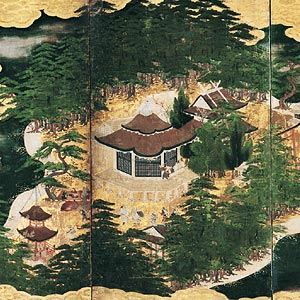January 13 - August 15, 2004 The selection of screens on display will be changed on April 6 |

Golden Fantasies: Japanese Screens from New York Private Collections is made possible with support from Erika and Peter Aron, Peggy and Richard M. Danziger, Mary Livingston Griggs and Mary Griggs Burke Foundation, John and Polly Guth, Dr. John C. Weber, Richard Fishbein and Estelle Bender, and Ronald J. Anderson.
Additional support for the Asia Society's Cultural Programs is provided by the Friends of Asian Arts, The Starr Foundation, Doris Duke Charitable Foundation, Blanchette Hooker Rockefeller Fund, Institute of Museum and Library Services, Mr. and Mrs. Robert M. Beningson, Hazen Polsky Foundation, Altria, American Express, and the New York State Council on the Arts.
Folding screens are luxuriously beautiful and uniquely designed pictorial compositions that present the social and cultural ideals of their time. Golden Fantasies assembles superb examples of folding screens, many from private New York collections and previously unseen by the public. The works in this exhibition fall into three broad categories: works drawn from well-known narratives, both classical courtly romances and medieval warrior epics; idealized scenes of entertainment, relaxation, pilgrimage, or labor; and pastoral images that require the viewer's knowledge of cultural characteristics to recognize the underlying theme. Although the screens vary in their subject matter and use, their portrayal of human activities and diversions provides a common thread. In some screens, scenes of people are depicted in a literal fashion; in others, more oblique suggestions are made through poetic and literary allusions.
The screens range in date from the mid-sixteenth century through the late seventeenth century, a period of increasing trade, commerce, and urbanization in Japan. Screens, which had formerly been the exclusive purview of the aristocracy and the military elite, became desirable objects for the homes of the rising merchant class at this time. The early seventeenth century also saw an end to a long period of civil war, after which the warrior class settled down in the cities. Fueled by this changing social climate, new themes became popular for screen paintings, reflecting an interest in other city-dwellers and their lives, a fantasy of escape from the urban world, and a desire to demonstrate cultural achievement.
![]()

Exhibition Catalog and merchandise
Read the press release